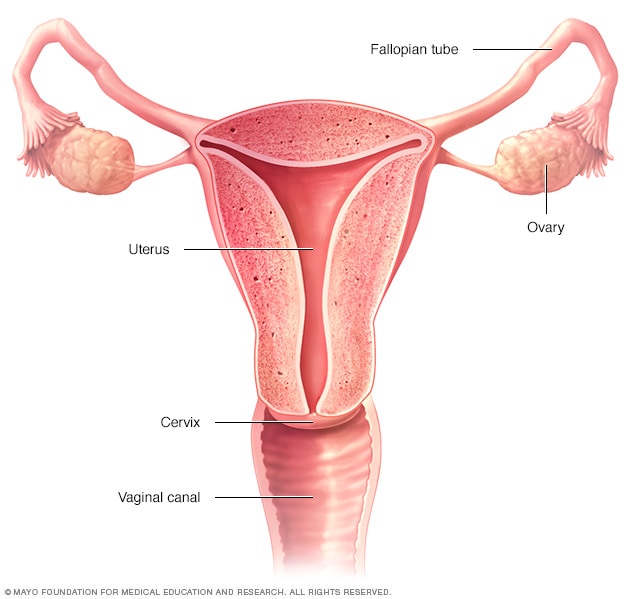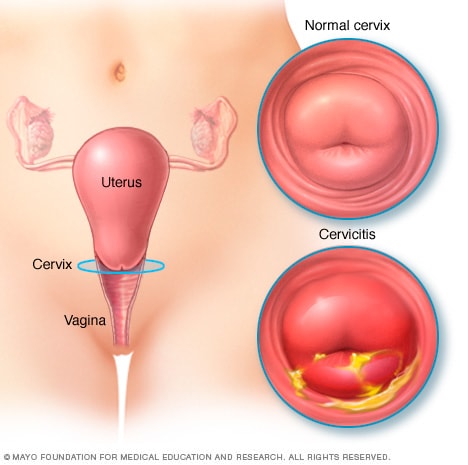Cervicitis
Cervicitis
overview
Female reproductive system

Female reproductive system
The ovaries, fallopian tubes, uterus, cervix and vagina (vaginal canal) make up the female reproductive system.
Cervicitis is an inflammation of the cervix, the lower, narrow end of the uterus that opens into the vagina.
Possible symptoms of cervicitis include bleeding between menstrual periods, pain during intercourse or during a gynecological exam, and abnormal vaginal discharge. However, it is also possible to have cervicitis and have no signs or symptoms.
Cervicitis often results from a sexually transmitted infection such as chlamydia or gonorrhea. Cervicitis can also develop from non-infectious causes. Successful treatment of cervicitis involves treating the underlying cause of the inflammation.
Symptoms
Cervicitis

Cervicitis
With cervicitis, an inflammation of your cervix, your cervix appears red and irritated and may produce purulent discharge.
Most of the time, cervicitis does not cause any signs and symptoms, and you may not know that you have the condition until after a pelvic exam performed by your doctor for another reason. If you have signs and symptoms, they may include:
- Große Mengen an ungewöhnlichem Vaginalausfluss
- Häufiges, schmerzhaftes Wasserlassen
- Schmerzen beim Sex
- Blutungen zwischen den Menstruationsperioden
- Vaginale Blutungen nach dem Sex, die nicht mit einer Menstruation verbunden sind
When to go to the doctor?
See your doctor if you:
- Anhaltender, ungewöhnlicher vaginaler Ausfluss
- Nichtmenstruelle Blutungen aus der Scheide
- Schmerzen beim Sex
Causes
Possible causes of cervicitis include:
- Sexuell übertragbare Infektionen. Am häufigsten werden die bakteriellen und viralen Infektionen, die eine Zervizitis verursachen, durch sexuellen Kontakt übertragen. Zervizitis kann aus häufigen sexuell übertragbaren Infektionen (STIs) resultieren, einschließlich Gonorrhö, Chlamydien, Trichomoniasis und Herpes genitalis.
- Allergische Reaktionen. Eine Allergie, entweder gegen Spermizide zur Empfängnisverhütung oder gegen Latex in Kondomen, kann zu Zervizitis führen. Eine Reaktion auf Damenhygieneprodukte wie Duschen oder Damendeodorants kann ebenfalls eine Zervizitis verursachen.
- Bakterielle Überwucherung. Eine übermäßige Vermehrung einiger Bakterien, die normalerweise in der Vagina vorhanden sind (bakterielle Vaginose), kann zu Zervizitis führen.
Risk factors
You are at higher risk of cervicitis if you:
- Sich auf riskantes Sexualverhalten einlassen, wie ungeschützter Sex, Sex mit mehreren Partnern oder Sex mit jemandem, der sich auf riskante Verhaltensweisen einlässt
- Begann schon früh mit Geschlechtsverkehr
- Haben Sie eine Geschichte von sexuell übertragbaren Infektionen
Complications
Your cervix acts as a barrier to prevent bacteria and viruses from entering your uterus. If the cervix is infected, there is an increased risk of the infection spreading to your uterus.
Cervicitis caused by gonorrhea or chlamydia can spread to the uterine lining and fallopian tubes and lead to pelvic inflammatory disease (PID), an infection of the female reproductive system that can cause fertility problems if left untreated.
Cervicitis can also increase the risk of contracting HIV from an infected sexual partner.
prevention
To reduce the risk of cervicitis from sexually transmitted infections, use condoms consistently and correctly every time you have sex. Condoms are very effective against the spread of STIs such as gonorrhea and chlamydia, which can lead to cervicitis. Being in a long-term relationship where both you and your uninfected partner have sex exclusively with each other can reduce your chances of getting an STI.
Sources:
- Ferri FF. Zervizitis. In: Ferri’s Clinical Advisor 2018. Philadelphia, Pa.: Elsevier; 2018. https://www.clinicalkey.com. Abgerufen am 2. September 2017.
- Behandlungsrichtlinien für sexuell übertragbare Krankheiten, 2015. Atlanta, Georgia: US Centers for Disease Control and Prevention. https://www.cdc.gov/std/tg2015/default.htm. Abgerufen am 10. September 2017.
- Bennett JE, et al., Hrsg. Vulvovaginitis und Zervizitis. In: Prinzipien und Praxis von Infektionskrankheiten von Mandell, Douglas und Bennett. 8. Aufl. Philadelphia, Pennsylvania: Saunders Elsevier; 2015. https://www.clinicalkey.com. Abgerufen am 2. September 2017.
- Marrazzo J. Akute Zervizitis. https://www.uptodate.com/contents/search. Abgerufen am 2. September 2017.
- Zervizitis. Merck Manual Verbraucherversion. http://www.merckmanuals.com/professional/gynecology-and-obstetrics/vaginitis,-cervicitis,-and-pelvic-flammatory-disease-pid/cervicitis. Abgerufen am 10. September 2017.

 Suche
Suche
 Mein Konto
Mein Konto